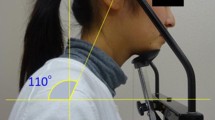Abstract
Our aim in this study was to evaluate hyoid bone movement trajectories and the age-related changes during swallowing in healthy subjects by ultrasonography. Data were obtained from 30 healthy volunteers (15 men, 15 women) in three age groups (20–39, 40–59, 60–79 years). The subjects were examined while sitting in an upright position, with the back against a wall to control movement. The transducer was placed in a longitudinal scan above the larynx. The subjects were then given 5 mL of mineral water. The water bolus was held in their mouth until they were forced to do a rapid swallow. The imaging was repeated five times for averaging. The movement was divided into 4 phases: slowly ascending phase (A–B, Elevation); rapidly ascending phase (B–C, Anterior); temporary pause phase (position of maximum rise, Remain); and rapidly and slowly descending shifts toward the resting position phase (C–D, Return). We easily visualized the hyoid bone trajectory by using ultrasonography. In all cases, ultrasonographic analysis of the hyoid bone was confirmed to have a similar trajectory, as determined with videofluoroscopy. The average swallowing duration measurements increased with age. The measurement of the maximally elevated point of the hyoid bone decreased with age. The movement of the hyoid bone during swallowing can be visualized by US. The trajectory of the hyoid bone in sagittal section indicated the capability of swallowing, and may detect some anomalies in swallowing.




Similar content being viewed by others
References
Logemann JA, Pauloski BR, Rademaker AW, Colangelo LA, Kahrilas PJ, Smith CH. Temporal and biomechanical characteristics of oropharyngeal swallow in younger and older men. J Speech Lang Hear Res. 2000;43:264–74.
Logemann JA, Pauloski BR, Rademaker AW, Kahrilas PJ. Oropharyngeal swallow in younger and older women: videofluoroscopic analysis. J Speech Lang Hear Res. 2002;45:434–45.
Sonies BC, Wang C, Sapper DJ. Evaluation of normal and abnormal hyoid bone movement during swallowing by use of ultrasound duplex-Doppler imaging. Ultrasound Med Biol. 1996;22:1169–75.
Kuhl V, Eicke BM, Dieterich M, Urban PP. Sonographic analysis of laryngeal elevation during swallowing. J Neurol. 2003;250:333–7.
Ekberg O, Feinberg MJ. Altered swallowing function in elderly patients without dysphagia: radiologic findings in 56 cases. Am J Roentgenol. 1991;156:1181–4.
Hafner G, Neuhuber A, Hirtenfelder S, Schmedler B, Eckel HE. Fiberoptic endoscopic evaluation of swallowing in intensive care unit patients. Eur Arch Otorhinolaryngol. 2008;265:441–6.
Martino R, Pron G, Diamant N. Screening for oropharyngeal dysphagia in stroke: insufficient evidence for guidelines. Dysphagia. 2000;15:19–30.
Saunders JB, Davis C, Miller ER. The mechanism of deglutition (second stage) as revealed by cine-radiography. Ann Otol Rhinol Laryngol. 1951;60:897–916.
Ramsey GH, Watson JS, Gramiak R, Weinberg SA. Cinefluorographic analysis of the mechanism of swallowing. Radiology. 1955;64:498–518.
Perlman AL, VanDaele DJ, Otterbacher MS. Quantitative assessment of hyoid bone displacement from video images during swallowing. J Speech Hear Res. 1995;38:579–85.
Logemann JA, Kahrilas PJ, Kobara M, Vakil NB. The benefit of head rotation on pharyngoesophageal dysphagia. Arch Phys Med Rehabil. 1989;70:767–71.
Ekberg O. Posture of the head and pharyngeal swallowing. Acta Radiol Diagn. 1986;27:691–6.
Chi-Fishman G. Quantitative lingual, pharyngeal and laryngeal ultrasonography in swallowing research: a technical review. Clin Linguist Phon. 2005;19:589–604.
Kendall KA, Leonard RJ. Hyoid movement during swallowing in older patients with dysphagia. Arch Otolaryngol Head Neck Surg. 2001;127:1224–9.
Campbell MJ, McComas AJ, Petito F. Physiological changes in ageing muscles. J Neurol Neurosurg Psychiatry. 1973;36:174–82.
Author information
Authors and Affiliations
Corresponding author
About this article
Cite this article
Yabunaka, K., Sanada, H., Sanada, S. et al. Sonographic assessment of hyoid bone movement during swallowing: a study of normal adults with advancing age. Radiol Phys Technol 4, 73–77 (2011). https://doi.org/10.1007/s12194-010-0107-9
Received:
Revised:
Accepted:
Published:
Issue Date:
DOI: https://doi.org/10.1007/s12194-010-0107-9




